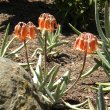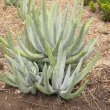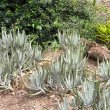| Botanical Name |
Cotyledon orbiculata var. oblonga |
| Family |
Crassulaceae - The crassula family. |
| Pronunciation |
kot-ee-LEE-don or-bic-yew-LAY-tuh |
| Common Name(s) |
IsiXhosa: iphewula; isundu
|
| Plant Group |
- Ground Cover A plant with a low-growing, spreading habit, grown specifically to cover the ground.
- Succulent A plant having fleshy stems or leaves often adapted to dry conditions.
|
| Plant Size |
- Medium
| Tree | 10m to 16m |
| Shrub | 1m to 2m |
| Perennial/ground cover | 40cm to 60cm |
| Bulb | 40cm to 60cm |
| Succulent | 40cm to 60cm |
|
| Position |
- Dry Shade Shady areas where soil has poor water retention or are dependent on rain for their moisture needs.
- Light or Dappled Shade Found below trees with sparse, open foliage. Ideal for the protection of herbaceous plants.
- Partial Shade The area is in shade for part of the day and in full sun for part of the day.
- Sun The area is in full sun for all or most of the day, all year round.
|
| General Information |
- Drought Tolerance: High The plant is well adapted to arid conditions; it can survive long periods of drought and high temperatures without extra water.
- Evergreen Plants that have leaves all year round.
- Frost: Half-hardy The plant is able to survive low temperatures and some frost but requires protection against severe frost.
- Sand tolerant Plants adapted to survive in nutrient poor, very sandy soils.
- Water Wise Plant species originating from low rainfall regions that require less water to survive and thrive than other plant species.
|
| Specific Information |
The plant branches from ground level, forming large clumps. The leaves are silvery-white to pale grey-green. With its spiky shaped leaves and silver-green colour, this cotyledon lends its texture, shape and colour to many garden situations.
|
| Ad Break |
|
| Flowers |
| Description |
pendulous, tubular blooms in loose heads on a long maroon stem
|
| Season |
- Winter Plants will seldom bloom for the entire season as given in the list, but should flower during a period within these parameters.
|
| Colour |
|
| Growth Rate |
- Fast Specifying growth rate can be very misleading as there is considerable variation of growth rate depending on type and species of plant, available water, supplementary feeding, mulching and general care, as well as the plants suitability and adaptability to the garden environment.
|
| Plant Uses |
- Attracts bees, butterflies or other insects This plant attracts insects which can be food for birds or other creatures in your garden.
- Attracts Birds This plant will attract birds.
- Border A strip of ground, at the edge of a driveway or path in which ornamental plants or shrubs are planted.
- Container Trees, shrubs and ornamental species that can adapt to growing in a restricted environment.
- Edging A low growing plant that provides softness or definition to the edges of a bed or walkway.
- Foliage Plant Plants grown because their foliage is colorful or unique. Many of these plants have insignificant flowers.
- Ground Cover Low-lying plants that spread fast, require minimal maintenance, and cover large expanses or bare areas between bulbs or shrubs. They provide protection from erosion and drought and improve the visual appearance of the garden.
- Rock Garden An area constructed of larger rocks, arranged naturally, to emphasise the use of stones as a main element. Generally plants used do not need a lot of care.
- Stabilize Banks Plant is used to prevent soil erosion because their roots will form a mat that stabilizes the soil and keeps it from washing away in heavy rains.
- Suitable for coastal gardens Plants adapted to dry, sandy soil, forceful wind, limited rainfall and intense sunlight.
- Wild Garden An indigenous garden planted for the benefit of wildlife and birds. Provides food, water, a variety of mini-biomes and no poisonous chemicals are used.
|
| Distribution and Habitat |
widespread in the Eastern Cape, KwaZulu-Natal and Mpumalanga and in adjacent areas of the Free State, Gauteng, North West and Limpopo, most often in rocky outcrops in grasslands and karoo environments
|
| Planting Suggestions |
Plant in well-drained soil with a little compost if needed. Mulch lightly to retain water in dry areas but don't over-water as it will rot. If grown in too much shade the plant will lose its tight growth-form and become lanky.
|
| Medicinal Uses |
The fleshy part of the leaf is used to soften and remove corns and warts. The heated leaf is used as a poultice for boils and the warmed juice for earache and toothache. A single leaf can be eaten as a vermifuge and it has been reported that the juice can be used to treat epilepsy. A dried leaf is used by the Southern Sotho as a protective charm for an orphan child and as a plaything.
|
| Ad Break |
|








Discuss this plant
Share knowledge, ask a question or give an experience.